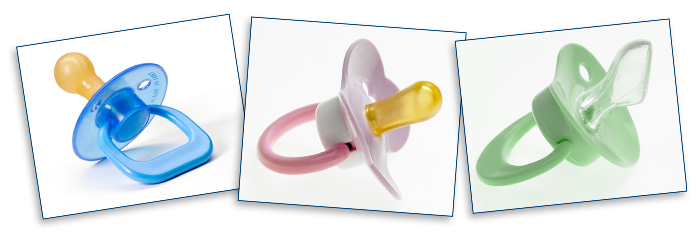
As an orthodontist practice, the question that often comes up with new parents is, “Which pacifier is better”? Honestly, the answer is pretty simple. Only your baby knows for sure, as it really is whichever one soothes them best. So once your baby’s breastfeeding or bottling habits are firmly established you may choose to calm your infant with a pacifier, but which one do you choose?
The baby pacifier market was valued at nearly $400 million in 2019. While some infants only suckle during feedings, others may benefit from sucking at times of fussiness or irritability. Research and experts agree the benefits of pacifier use include analgesic effects and shorter hospital stays for pre-term infants. The American Academy of Pediatrics (AAP) and American Academy of Family Physicians (AAFP) also recommend their use in comforting infants one month and older at the onset of sleep to reduce the risk of sudden infant death syndrome (SIDS). So, we know that pacifiers work and that some infants benefit from them, but why are there so many to choose from?
 There are three main types of pacifier nipple. The rounded or crown nipple is designed to function most like a bottle for bottle fed babies. A symmetrical pacifier is shaped most naturally like mom and mimics breast feeding. Lastly is the orthodontic pacifier with a flat tip. This pacifier is designed to support the shape of your baby’s developing palate and jaw. When sucking on an orthodontic pacifier, the nipple flattens to the palette to provide the most natural sucking action, reducing pressure on the gums and developing teeth. Studies suggest these pacifiers can reduce open bite and overbite issues typically seen with other pacifiers.
There are three main types of pacifier nipple. The rounded or crown nipple is designed to function most like a bottle for bottle fed babies. A symmetrical pacifier is shaped most naturally like mom and mimics breast feeding. Lastly is the orthodontic pacifier with a flat tip. This pacifier is designed to support the shape of your baby’s developing palate and jaw. When sucking on an orthodontic pacifier, the nipple flattens to the palette to provide the most natural sucking action, reducing pressure on the gums and developing teeth. Studies suggest these pacifiers can reduce open bite and overbite issues typically seen with other pacifiers.
“Whichever you choose, be sure to avoid novelty pacifiers or anything with excess weight,” said Dr. Razdolsky. “These pacifiers place undue burden on baby’s developing palate and teeth. Further, the novelty ones may not be properly regulated, suitably sized, age appropriate or can even have parts that can break off.”
According to Dr. Razdolsky, equally as important in choosing the right pacifier to soothe your infant, is knowing when to work toward weening baby off the pacifier. “While choosing the right pacifier may seem important, it is what we do from there that really helps determine, or in some instances defines their orthodontic health as they develop,” said Dr. Razdolsky.
Both the AAP and AAFP recommend limiting or stopping pacifier use at 6 months. After 9 months children can develop an emotional attachment to their binky, so have a goal of having your child off the pacifier at no later than one year. As a parent of four grown children, Dr. Razdolsky understands that sometimes a pacifier is needed. However, the longer it takes to wean your child off the pacifier, the more difficult it can become and the more harmful it may be to their overall growth and development of their mouth, palate, and teeth. While it is said that an orthodontic pacifier may cause less open bite or overbite problems than traditional ones, Dr. Razdolsky says the best way to mitigate orthodontic development issues is by limiting pacifier time and taking the pacifier away after the first year.



